Research Proposal: Effectiveness of Chlorhexidine in ICUs
VerifiedAdded on 2020/05/16
|21
|4791
|58
Report
AI Summary
This research proposal investigates the effectiveness of chlorhexidine gluconate (CHG) in reducing nosocomial infections, particularly in intensive care units (ICUs). The proposal outlines a cluster randomized and crossover controlled trial designed to measure the impact of CHG bathing on ventilator-associated pneumonia (VAP), central line-associated bloodstream infections (CLASBSI), and catheter-associated urinary tract infections (CAUTI). The research will employ a quantitative methodology, incorporating training for infection control nurses to accurately identify and assess infections based on CDC definitions. The literature review highlights existing studies supporting CHG's efficacy in reducing HAIs and MDROs. Secondary outcomes include infection rates, blood culture contamination, length of hospital stay, and nurses' CHG bathing skills. The study aims to contribute to evidence-based practice by providing insights into the use of CHG in clinical settings to improve patient safety and healthcare outcomes. Ethical considerations and dissemination plans are also included.
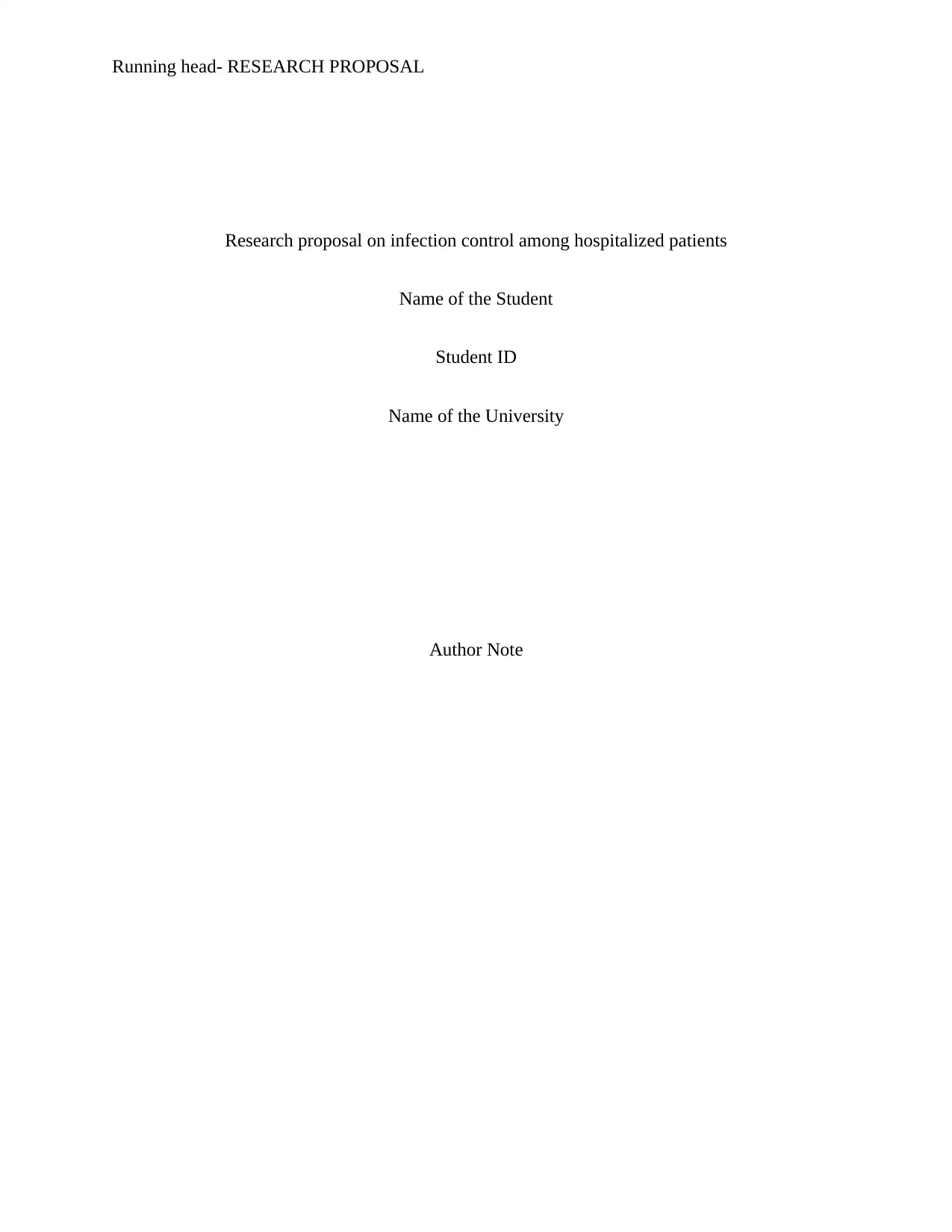
Running head- RESEARCH PROPOSAL
Research proposal on infection control among hospitalized patients
Name of the Student
Student ID
Name of the University
Author Note
Research proposal on infection control among hospitalized patients
Name of the Student
Student ID
Name of the University
Author Note
Paraphrase This Document
Need a fresh take? Get an instant paraphrase of this document with our AI Paraphraser
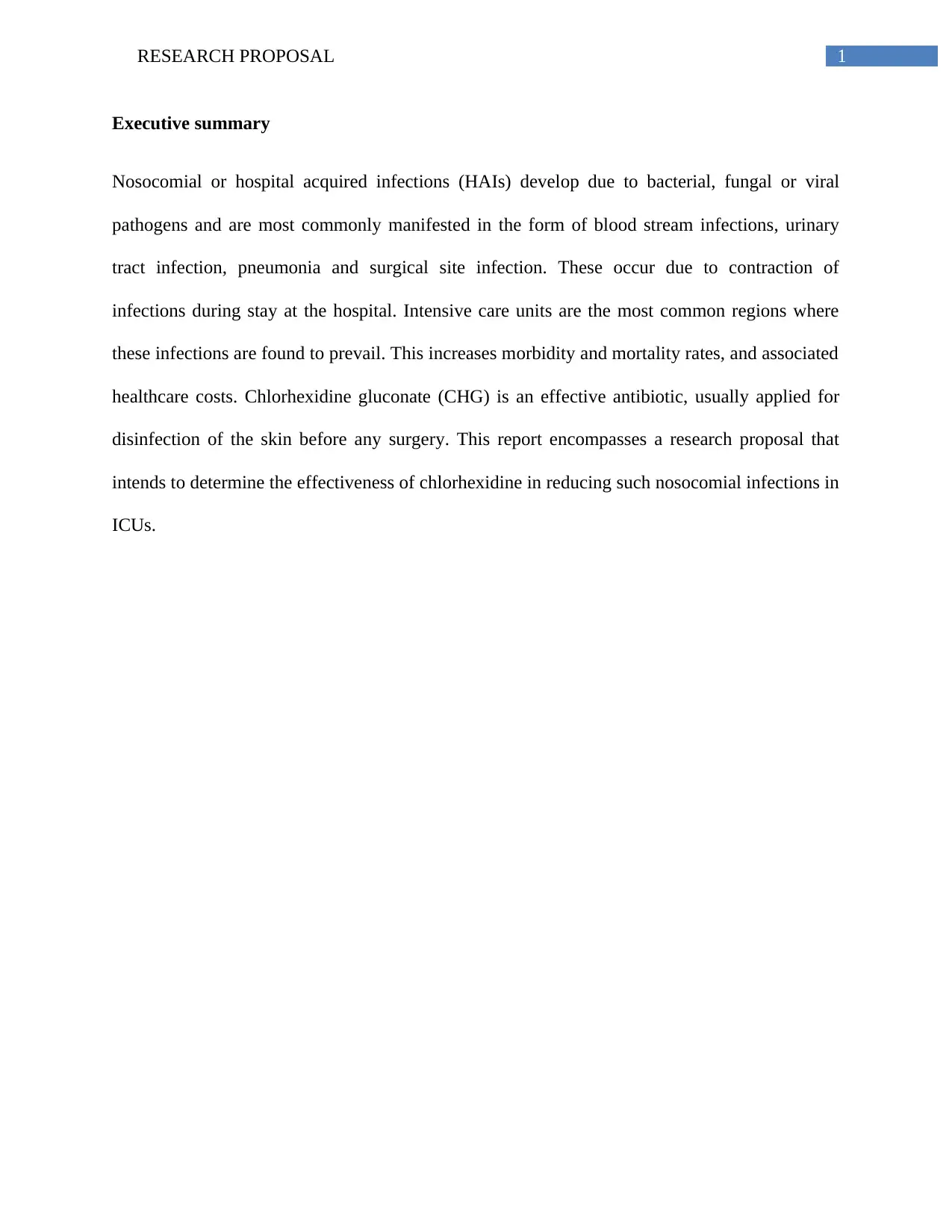
1RESEARCH PROPOSAL
Executive summary
Nosocomial or hospital acquired infections (HAIs) develop due to bacterial, fungal or viral
pathogens and are most commonly manifested in the form of blood stream infections, urinary
tract infection, pneumonia and surgical site infection. These occur due to contraction of
infections during stay at the hospital. Intensive care units are the most common regions where
these infections are found to prevail. This increases morbidity and mortality rates, and associated
healthcare costs. Chlorhexidine gluconate (CHG) is an effective antibiotic, usually applied for
disinfection of the skin before any surgery. This report encompasses a research proposal that
intends to determine the effectiveness of chlorhexidine in reducing such nosocomial infections in
ICUs.
Executive summary
Nosocomial or hospital acquired infections (HAIs) develop due to bacterial, fungal or viral
pathogens and are most commonly manifested in the form of blood stream infections, urinary
tract infection, pneumonia and surgical site infection. These occur due to contraction of
infections during stay at the hospital. Intensive care units are the most common regions where
these infections are found to prevail. This increases morbidity and mortality rates, and associated
healthcare costs. Chlorhexidine gluconate (CHG) is an effective antibiotic, usually applied for
disinfection of the skin before any surgery. This report encompasses a research proposal that
intends to determine the effectiveness of chlorhexidine in reducing such nosocomial infections in
ICUs.
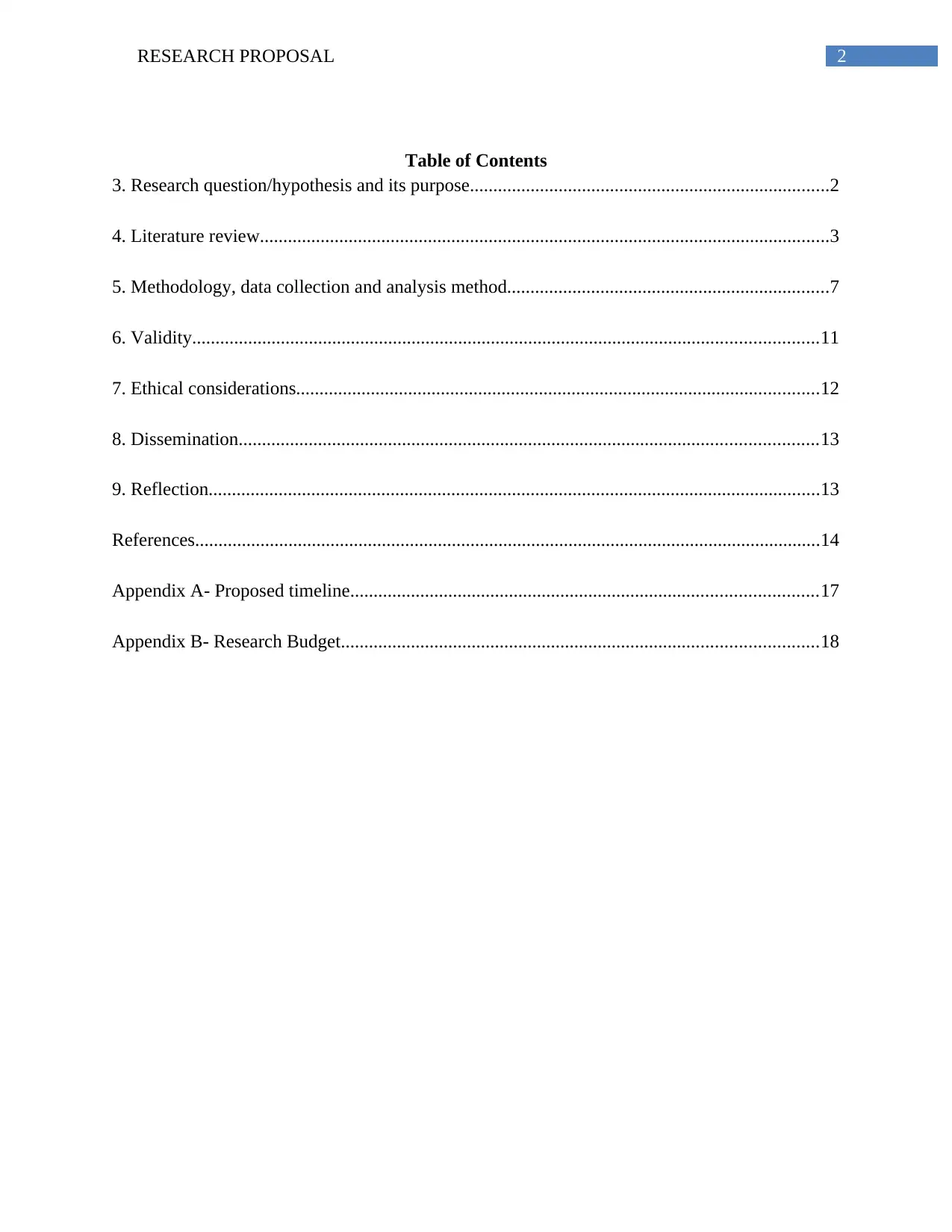
2RESEARCH PROPOSAL
Table of Contents
3. Research question/hypothesis and its purpose.............................................................................2
4. Literature review..........................................................................................................................3
5. Methodology, data collection and analysis method.....................................................................7
6. Validity......................................................................................................................................11
7. Ethical considerations................................................................................................................12
8. Dissemination............................................................................................................................13
9. Reflection...................................................................................................................................13
References......................................................................................................................................14
Appendix A- Proposed timeline....................................................................................................17
Appendix B- Research Budget......................................................................................................18
Table of Contents
3. Research question/hypothesis and its purpose.............................................................................2
4. Literature review..........................................................................................................................3
5. Methodology, data collection and analysis method.....................................................................7
6. Validity......................................................................................................................................11
7. Ethical considerations................................................................................................................12
8. Dissemination............................................................................................................................13
9. Reflection...................................................................................................................................13
References......................................................................................................................................14
Appendix A- Proposed timeline....................................................................................................17
Appendix B- Research Budget......................................................................................................18
⊘ This is a preview!⊘
Do you want full access?
Subscribe today to unlock all pages.

Trusted by 1+ million students worldwide
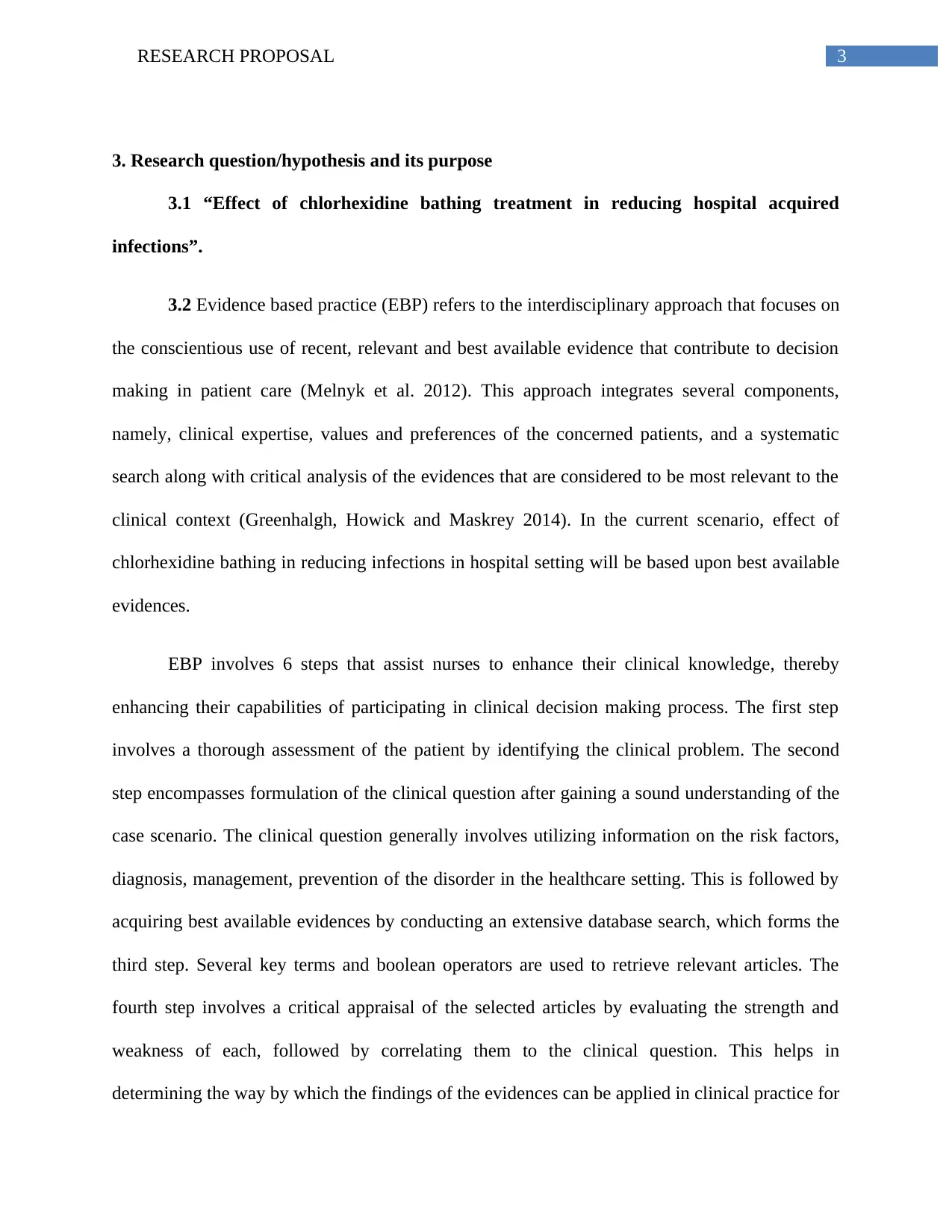
3RESEARCH PROPOSAL
3. Research question/hypothesis and its purpose
3.1 “Effect of chlorhexidine bathing treatment in reducing hospital acquired
infections”.
3.2 Evidence based practice (EBP) refers to the interdisciplinary approach that focuses on
the conscientious use of recent, relevant and best available evidence that contribute to decision
making in patient care (Melnyk et al. 2012). This approach integrates several components,
namely, clinical expertise, values and preferences of the concerned patients, and a systematic
search along with critical analysis of the evidences that are considered to be most relevant to the
clinical context (Greenhalgh, Howick and Maskrey 2014). In the current scenario, effect of
chlorhexidine bathing in reducing infections in hospital setting will be based upon best available
evidences.
EBP involves 6 steps that assist nurses to enhance their clinical knowledge, thereby
enhancing their capabilities of participating in clinical decision making process. The first step
involves a thorough assessment of the patient by identifying the clinical problem. The second
step encompasses formulation of the clinical question after gaining a sound understanding of the
case scenario. The clinical question generally involves utilizing information on the risk factors,
diagnosis, management, prevention of the disorder in the healthcare setting. This is followed by
acquiring best available evidences by conducting an extensive database search, which forms the
third step. Several key terms and boolean operators are used to retrieve relevant articles. The
fourth step involves a critical appraisal of the selected articles by evaluating the strength and
weakness of each, followed by correlating them to the clinical question. This helps in
determining the way by which the findings of the evidences can be applied in clinical practice for
3. Research question/hypothesis and its purpose
3.1 “Effect of chlorhexidine bathing treatment in reducing hospital acquired
infections”.
3.2 Evidence based practice (EBP) refers to the interdisciplinary approach that focuses on
the conscientious use of recent, relevant and best available evidence that contribute to decision
making in patient care (Melnyk et al. 2012). This approach integrates several components,
namely, clinical expertise, values and preferences of the concerned patients, and a systematic
search along with critical analysis of the evidences that are considered to be most relevant to the
clinical context (Greenhalgh, Howick and Maskrey 2014). In the current scenario, effect of
chlorhexidine bathing in reducing infections in hospital setting will be based upon best available
evidences.
EBP involves 6 steps that assist nurses to enhance their clinical knowledge, thereby
enhancing their capabilities of participating in clinical decision making process. The first step
involves a thorough assessment of the patient by identifying the clinical problem. The second
step encompasses formulation of the clinical question after gaining a sound understanding of the
case scenario. The clinical question generally involves utilizing information on the risk factors,
diagnosis, management, prevention of the disorder in the healthcare setting. This is followed by
acquiring best available evidences by conducting an extensive database search, which forms the
third step. Several key terms and boolean operators are used to retrieve relevant articles. The
fourth step involves a critical appraisal of the selected articles by evaluating the strength and
weakness of each, followed by correlating them to the clinical question. This helps in
determining the way by which the findings of the evidences can be applied in clinical practice for
Paraphrase This Document
Need a fresh take? Get an instant paraphrase of this document with our AI Paraphraser
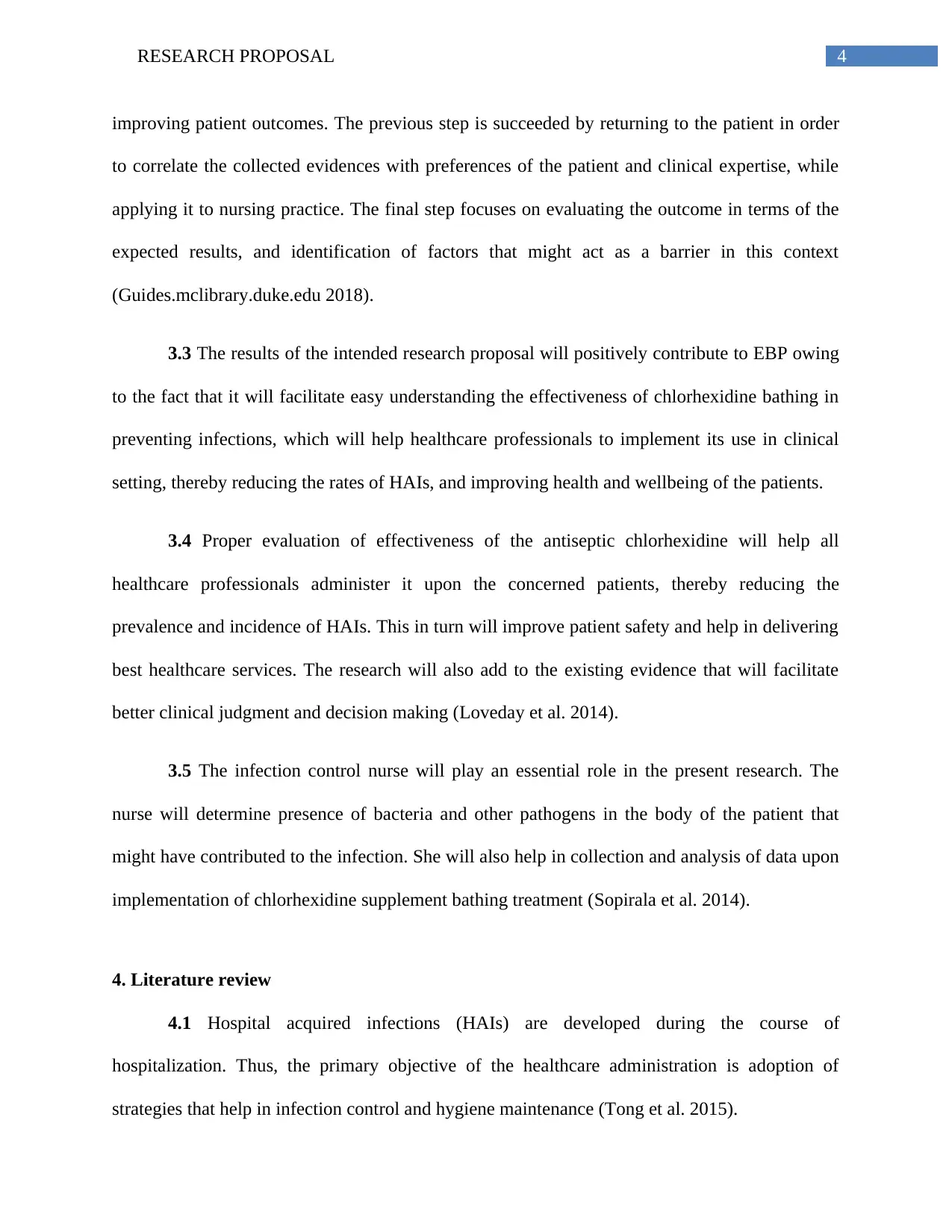
4RESEARCH PROPOSAL
improving patient outcomes. The previous step is succeeded by returning to the patient in order
to correlate the collected evidences with preferences of the patient and clinical expertise, while
applying it to nursing practice. The final step focuses on evaluating the outcome in terms of the
expected results, and identification of factors that might act as a barrier in this context
(Guides.mclibrary.duke.edu 2018).
3.3 The results of the intended research proposal will positively contribute to EBP owing
to the fact that it will facilitate easy understanding the effectiveness of chlorhexidine bathing in
preventing infections, which will help healthcare professionals to implement its use in clinical
setting, thereby reducing the rates of HAIs, and improving health and wellbeing of the patients.
3.4 Proper evaluation of effectiveness of the antiseptic chlorhexidine will help all
healthcare professionals administer it upon the concerned patients, thereby reducing the
prevalence and incidence of HAIs. This in turn will improve patient safety and help in delivering
best healthcare services. The research will also add to the existing evidence that will facilitate
better clinical judgment and decision making (Loveday et al. 2014).
3.5 The infection control nurse will play an essential role in the present research. The
nurse will determine presence of bacteria and other pathogens in the body of the patient that
might have contributed to the infection. She will also help in collection and analysis of data upon
implementation of chlorhexidine supplement bathing treatment (Sopirala et al. 2014).
4. Literature review
4.1 Hospital acquired infections (HAIs) are developed during the course of
hospitalization. Thus, the primary objective of the healthcare administration is adoption of
strategies that help in infection control and hygiene maintenance (Tong et al. 2015).
improving patient outcomes. The previous step is succeeded by returning to the patient in order
to correlate the collected evidences with preferences of the patient and clinical expertise, while
applying it to nursing practice. The final step focuses on evaluating the outcome in terms of the
expected results, and identification of factors that might act as a barrier in this context
(Guides.mclibrary.duke.edu 2018).
3.3 The results of the intended research proposal will positively contribute to EBP owing
to the fact that it will facilitate easy understanding the effectiveness of chlorhexidine bathing in
preventing infections, which will help healthcare professionals to implement its use in clinical
setting, thereby reducing the rates of HAIs, and improving health and wellbeing of the patients.
3.4 Proper evaluation of effectiveness of the antiseptic chlorhexidine will help all
healthcare professionals administer it upon the concerned patients, thereby reducing the
prevalence and incidence of HAIs. This in turn will improve patient safety and help in delivering
best healthcare services. The research will also add to the existing evidence that will facilitate
better clinical judgment and decision making (Loveday et al. 2014).
3.5 The infection control nurse will play an essential role in the present research. The
nurse will determine presence of bacteria and other pathogens in the body of the patient that
might have contributed to the infection. She will also help in collection and analysis of data upon
implementation of chlorhexidine supplement bathing treatment (Sopirala et al. 2014).
4. Literature review
4.1 Hospital acquired infections (HAIs) are developed during the course of
hospitalization. Thus, the primary objective of the healthcare administration is adoption of
strategies that help in infection control and hygiene maintenance (Tong et al. 2015).
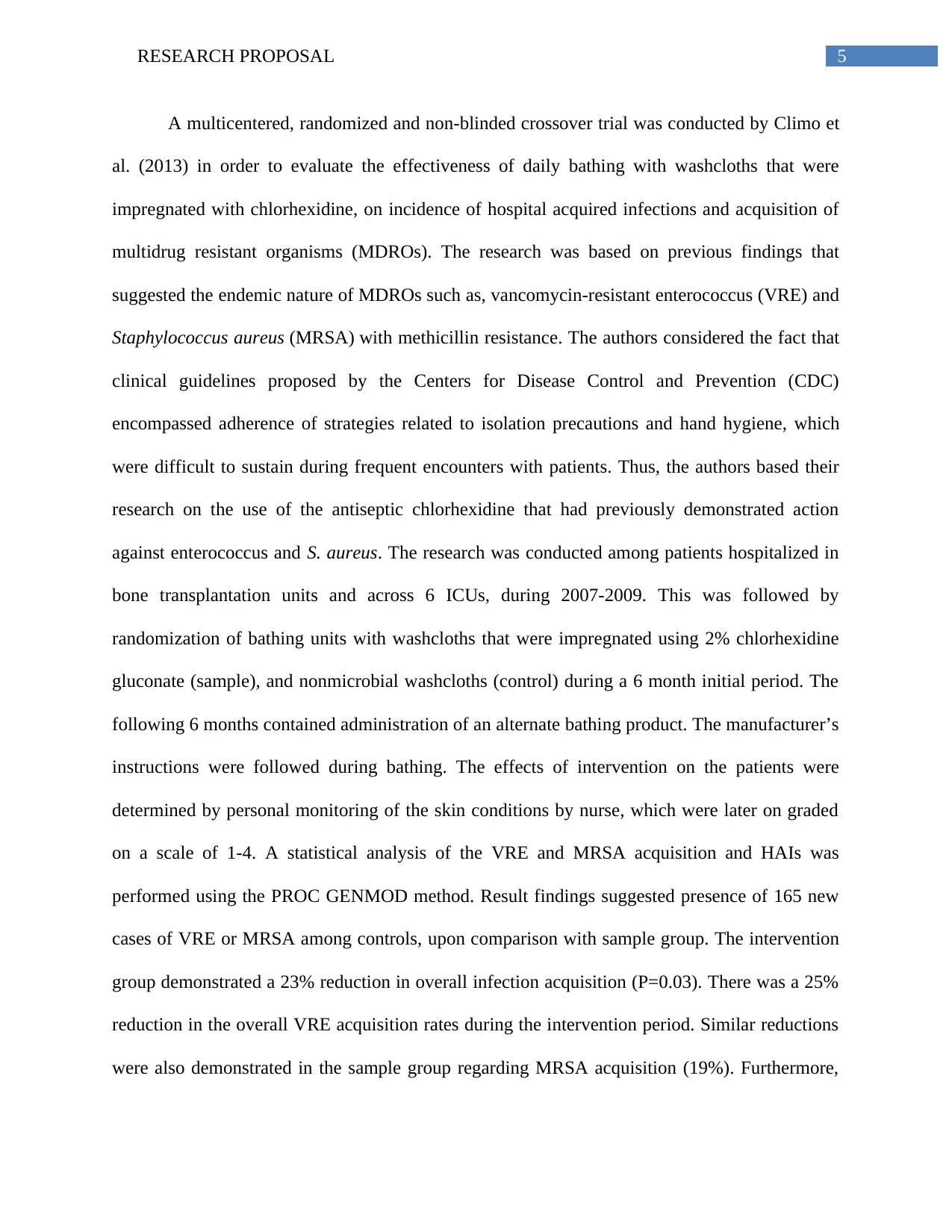
5RESEARCH PROPOSAL
A multicentered, randomized and non-blinded crossover trial was conducted by Climo et
al. (2013) in order to evaluate the effectiveness of daily bathing with washcloths that were
impregnated with chlorhexidine, on incidence of hospital acquired infections and acquisition of
multidrug resistant organisms (MDROs). The research was based on previous findings that
suggested the endemic nature of MDROs such as, vancomycin-resistant enterococcus (VRE) and
Staphylococcus aureus (MRSA) with methicillin resistance. The authors considered the fact that
clinical guidelines proposed by the Centers for Disease Control and Prevention (CDC)
encompassed adherence of strategies related to isolation precautions and hand hygiene, which
were difficult to sustain during frequent encounters with patients. Thus, the authors based their
research on the use of the antiseptic chlorhexidine that had previously demonstrated action
against enterococcus and S. aureus. The research was conducted among patients hospitalized in
bone transplantation units and across 6 ICUs, during 2007-2009. This was followed by
randomization of bathing units with washcloths that were impregnated using 2% chlorhexidine
gluconate (sample), and nonmicrobial washcloths (control) during a 6 month initial period. The
following 6 months contained administration of an alternate bathing product. The manufacturer’s
instructions were followed during bathing. The effects of intervention on the patients were
determined by personal monitoring of the skin conditions by nurse, which were later on graded
on a scale of 1-4. A statistical analysis of the VRE and MRSA acquisition and HAIs was
performed using the PROC GENMOD method. Result findings suggested presence of 165 new
cases of VRE or MRSA among controls, upon comparison with sample group. The intervention
group demonstrated a 23% reduction in overall infection acquisition (P=0.03). There was a 25%
reduction in the overall VRE acquisition rates during the intervention period. Similar reductions
were also demonstrated in the sample group regarding MRSA acquisition (19%). Furthermore,
A multicentered, randomized and non-blinded crossover trial was conducted by Climo et
al. (2013) in order to evaluate the effectiveness of daily bathing with washcloths that were
impregnated with chlorhexidine, on incidence of hospital acquired infections and acquisition of
multidrug resistant organisms (MDROs). The research was based on previous findings that
suggested the endemic nature of MDROs such as, vancomycin-resistant enterococcus (VRE) and
Staphylococcus aureus (MRSA) with methicillin resistance. The authors considered the fact that
clinical guidelines proposed by the Centers for Disease Control and Prevention (CDC)
encompassed adherence of strategies related to isolation precautions and hand hygiene, which
were difficult to sustain during frequent encounters with patients. Thus, the authors based their
research on the use of the antiseptic chlorhexidine that had previously demonstrated action
against enterococcus and S. aureus. The research was conducted among patients hospitalized in
bone transplantation units and across 6 ICUs, during 2007-2009. This was followed by
randomization of bathing units with washcloths that were impregnated using 2% chlorhexidine
gluconate (sample), and nonmicrobial washcloths (control) during a 6 month initial period. The
following 6 months contained administration of an alternate bathing product. The manufacturer’s
instructions were followed during bathing. The effects of intervention on the patients were
determined by personal monitoring of the skin conditions by nurse, which were later on graded
on a scale of 1-4. A statistical analysis of the VRE and MRSA acquisition and HAIs was
performed using the PROC GENMOD method. Result findings suggested presence of 165 new
cases of VRE or MRSA among controls, upon comparison with sample group. The intervention
group demonstrated a 23% reduction in overall infection acquisition (P=0.03). There was a 25%
reduction in the overall VRE acquisition rates during the intervention period. Similar reductions
were also demonstrated in the sample group regarding MRSA acquisition (19%). Furthermore,
⊘ This is a preview!⊘
Do you want full access?
Subscribe today to unlock all pages.

Trusted by 1+ million students worldwide
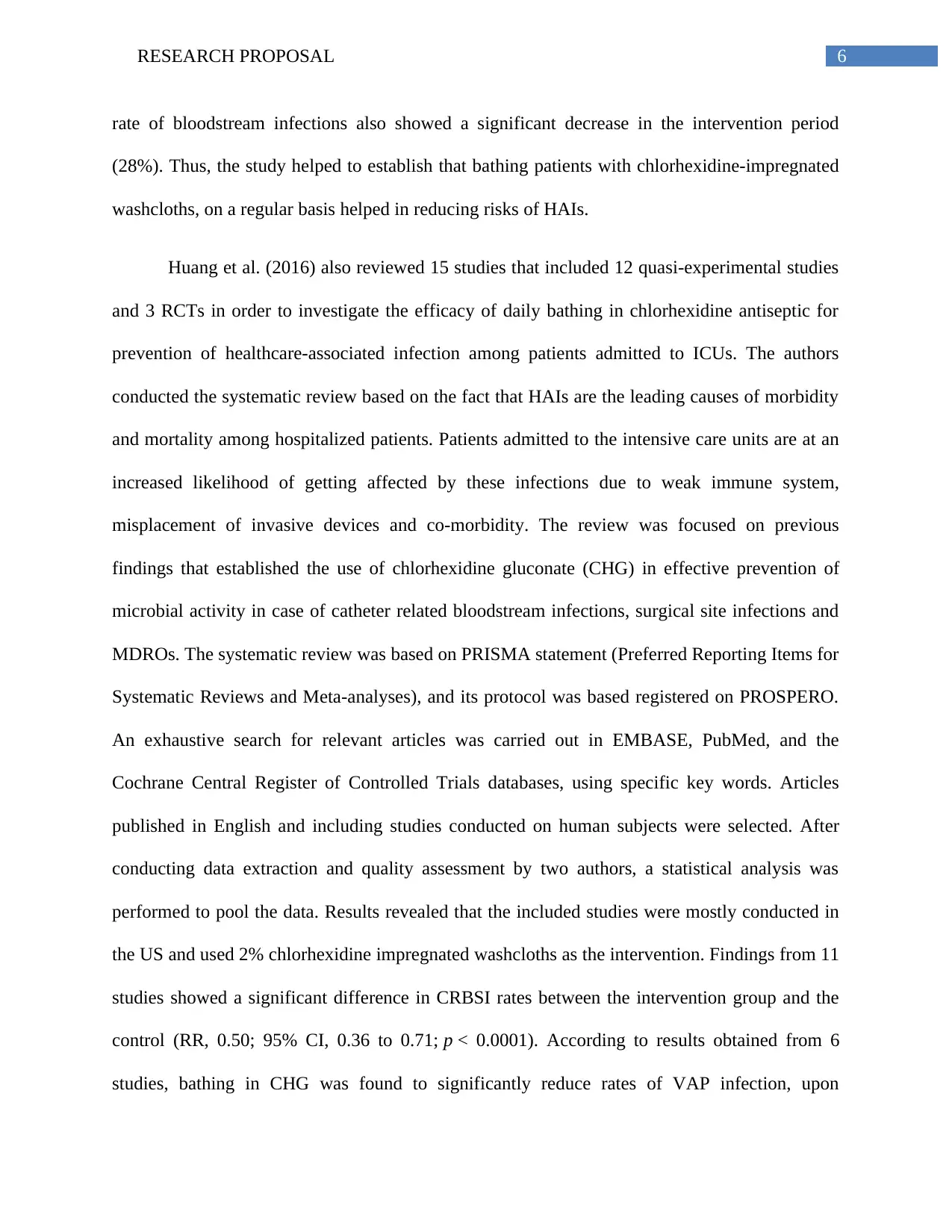
6RESEARCH PROPOSAL
rate of bloodstream infections also showed a significant decrease in the intervention period
(28%). Thus, the study helped to establish that bathing patients with chlorhexidine-impregnated
washcloths, on a regular basis helped in reducing risks of HAIs.
Huang et al. (2016) also reviewed 15 studies that included 12 quasi-experimental studies
and 3 RCTs in order to investigate the efficacy of daily bathing in chlorhexidine antiseptic for
prevention of healthcare-associated infection among patients admitted to ICUs. The authors
conducted the systematic review based on the fact that HAIs are the leading causes of morbidity
and mortality among hospitalized patients. Patients admitted to the intensive care units are at an
increased likelihood of getting affected by these infections due to weak immune system,
misplacement of invasive devices and co-morbidity. The review was focused on previous
findings that established the use of chlorhexidine gluconate (CHG) in effective prevention of
microbial activity in case of catheter related bloodstream infections, surgical site infections and
MDROs. The systematic review was based on PRISMA statement (Preferred Reporting Items for
Systematic Reviews and Meta-analyses), and its protocol was based registered on PROSPERO.
An exhaustive search for relevant articles was carried out in EMBASE, PubMed, and the
Cochrane Central Register of Controlled Trials databases, using specific key words. Articles
published in English and including studies conducted on human subjects were selected. After
conducting data extraction and quality assessment by two authors, a statistical analysis was
performed to pool the data. Results revealed that the included studies were mostly conducted in
the US and used 2% chlorhexidine impregnated washcloths as the intervention. Findings from 11
studies showed a significant difference in CRBSI rates between the intervention group and the
control (RR, 0.50; 95% CI, 0.36 to 0.71; p < 0.0001). According to results obtained from 6
studies, bathing in CHG was found to significantly reduce rates of VAP infection, upon
rate of bloodstream infections also showed a significant decrease in the intervention period
(28%). Thus, the study helped to establish that bathing patients with chlorhexidine-impregnated
washcloths, on a regular basis helped in reducing risks of HAIs.
Huang et al. (2016) also reviewed 15 studies that included 12 quasi-experimental studies
and 3 RCTs in order to investigate the efficacy of daily bathing in chlorhexidine antiseptic for
prevention of healthcare-associated infection among patients admitted to ICUs. The authors
conducted the systematic review based on the fact that HAIs are the leading causes of morbidity
and mortality among hospitalized patients. Patients admitted to the intensive care units are at an
increased likelihood of getting affected by these infections due to weak immune system,
misplacement of invasive devices and co-morbidity. The review was focused on previous
findings that established the use of chlorhexidine gluconate (CHG) in effective prevention of
microbial activity in case of catheter related bloodstream infections, surgical site infections and
MDROs. The systematic review was based on PRISMA statement (Preferred Reporting Items for
Systematic Reviews and Meta-analyses), and its protocol was based registered on PROSPERO.
An exhaustive search for relevant articles was carried out in EMBASE, PubMed, and the
Cochrane Central Register of Controlled Trials databases, using specific key words. Articles
published in English and including studies conducted on human subjects were selected. After
conducting data extraction and quality assessment by two authors, a statistical analysis was
performed to pool the data. Results revealed that the included studies were mostly conducted in
the US and used 2% chlorhexidine impregnated washcloths as the intervention. Findings from 11
studies showed a significant difference in CRBSI rates between the intervention group and the
control (RR, 0.50; 95% CI, 0.36 to 0.71; p < 0.0001). According to results obtained from 6
studies, bathing in CHG was found to significantly reduce rates of VAP infection, upon
Paraphrase This Document
Need a fresh take? Get an instant paraphrase of this document with our AI Paraphraser
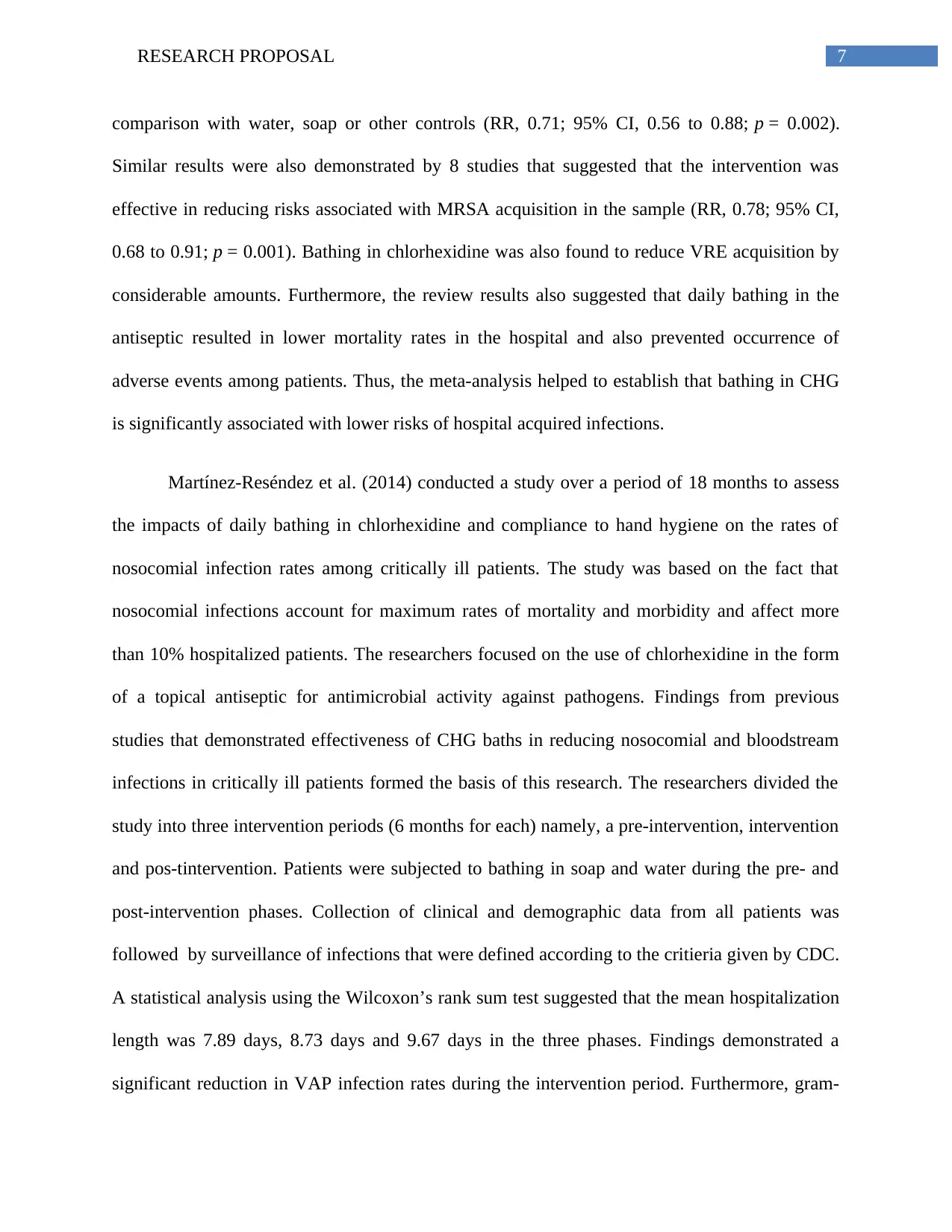
7RESEARCH PROPOSAL
comparison with water, soap or other controls (RR, 0.71; 95% CI, 0.56 to 0.88; p = 0.002).
Similar results were also demonstrated by 8 studies that suggested that the intervention was
effective in reducing risks associated with MRSA acquisition in the sample (RR, 0.78; 95% CI,
0.68 to 0.91; p = 0.001). Bathing in chlorhexidine was also found to reduce VRE acquisition by
considerable amounts. Furthermore, the review results also suggested that daily bathing in the
antiseptic resulted in lower mortality rates in the hospital and also prevented occurrence of
adverse events among patients. Thus, the meta-analysis helped to establish that bathing in CHG
is significantly associated with lower risks of hospital acquired infections.
Martínez-Reséndez et al. (2014) conducted a study over a period of 18 months to assess
the impacts of daily bathing in chlorhexidine and compliance to hand hygiene on the rates of
nosocomial infection rates among critically ill patients. The study was based on the fact that
nosocomial infections account for maximum rates of mortality and morbidity and affect more
than 10% hospitalized patients. The researchers focused on the use of chlorhexidine in the form
of a topical antiseptic for antimicrobial activity against pathogens. Findings from previous
studies that demonstrated effectiveness of CHG baths in reducing nosocomial and bloodstream
infections in critically ill patients formed the basis of this research. The researchers divided the
study into three intervention periods (6 months for each) namely, a pre-intervention, intervention
and pos-tintervention. Patients were subjected to bathing in soap and water during the pre- and
post-intervention phases. Collection of clinical and demographic data from all patients was
followed by surveillance of infections that were defined according to the critieria given by CDC.
A statistical analysis using the Wilcoxon’s rank sum test suggested that the mean hospitalization
length was 7.89 days, 8.73 days and 9.67 days in the three phases. Findings demonstrated a
significant reduction in VAP infection rates during the intervention period. Furthermore, gram-
comparison with water, soap or other controls (RR, 0.71; 95% CI, 0.56 to 0.88; p = 0.002).
Similar results were also demonstrated by 8 studies that suggested that the intervention was
effective in reducing risks associated with MRSA acquisition in the sample (RR, 0.78; 95% CI,
0.68 to 0.91; p = 0.001). Bathing in chlorhexidine was also found to reduce VRE acquisition by
considerable amounts. Furthermore, the review results also suggested that daily bathing in the
antiseptic resulted in lower mortality rates in the hospital and also prevented occurrence of
adverse events among patients. Thus, the meta-analysis helped to establish that bathing in CHG
is significantly associated with lower risks of hospital acquired infections.
Martínez-Reséndez et al. (2014) conducted a study over a period of 18 months to assess
the impacts of daily bathing in chlorhexidine and compliance to hand hygiene on the rates of
nosocomial infection rates among critically ill patients. The study was based on the fact that
nosocomial infections account for maximum rates of mortality and morbidity and affect more
than 10% hospitalized patients. The researchers focused on the use of chlorhexidine in the form
of a topical antiseptic for antimicrobial activity against pathogens. Findings from previous
studies that demonstrated effectiveness of CHG baths in reducing nosocomial and bloodstream
infections in critically ill patients formed the basis of this research. The researchers divided the
study into three intervention periods (6 months for each) namely, a pre-intervention, intervention
and pos-tintervention. Patients were subjected to bathing in soap and water during the pre- and
post-intervention phases. Collection of clinical and demographic data from all patients was
followed by surveillance of infections that were defined according to the critieria given by CDC.
A statistical analysis using the Wilcoxon’s rank sum test suggested that the mean hospitalization
length was 7.89 days, 8.73 days and 9.67 days in the three phases. Findings demonstrated a
significant reduction in VAP infection rates during the intervention period. Furthermore, gram-
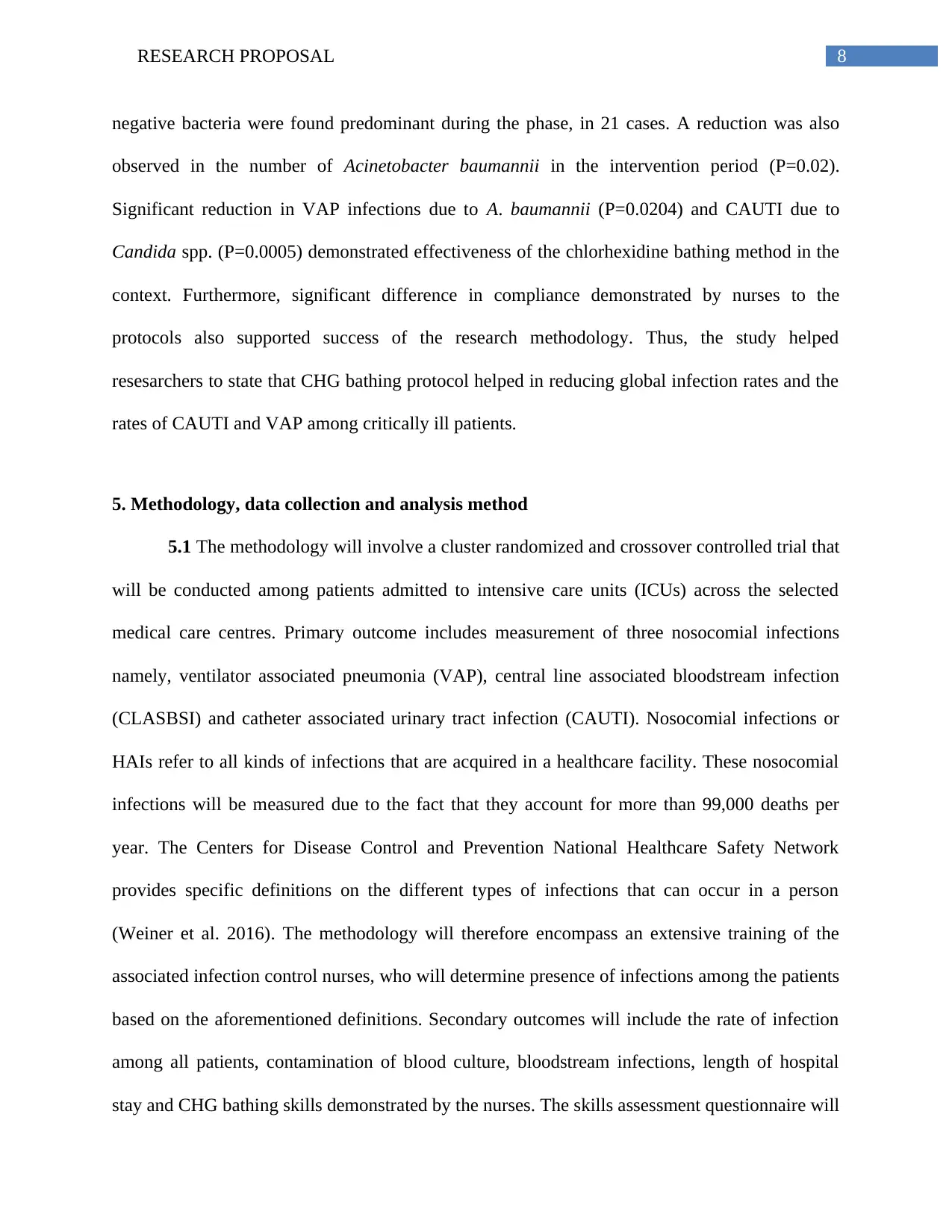
8RESEARCH PROPOSAL
negative bacteria were found predominant during the phase, in 21 cases. A reduction was also
observed in the number of Acinetobacter baumannii in the intervention period (P=0.02).
Significant reduction in VAP infections due to A. baumannii (P=0.0204) and CAUTI due to
Candida spp. (P=0.0005) demonstrated effectiveness of the chlorhexidine bathing method in the
context. Furthermore, significant difference in compliance demonstrated by nurses to the
protocols also supported success of the research methodology. Thus, the study helped
resesarchers to state that CHG bathing protocol helped in reducing global infection rates and the
rates of CAUTI and VAP among critically ill patients.
5. Methodology, data collection and analysis method
5.1 The methodology will involve a cluster randomized and crossover controlled trial that
will be conducted among patients admitted to intensive care units (ICUs) across the selected
medical care centres. Primary outcome includes measurement of three nosocomial infections
namely, ventilator associated pneumonia (VAP), central line associated bloodstream infection
(CLASBSI) and catheter associated urinary tract infection (CAUTI). Nosocomial infections or
HAIs refer to all kinds of infections that are acquired in a healthcare facility. These nosocomial
infections will be measured due to the fact that they account for more than 99,000 deaths per
year. The Centers for Disease Control and Prevention National Healthcare Safety Network
provides specific definitions on the different types of infections that can occur in a person
(Weiner et al. 2016). The methodology will therefore encompass an extensive training of the
associated infection control nurses, who will determine presence of infections among the patients
based on the aforementioned definitions. Secondary outcomes will include the rate of infection
among all patients, contamination of blood culture, bloodstream infections, length of hospital
stay and CHG bathing skills demonstrated by the nurses. The skills assessment questionnaire will
negative bacteria were found predominant during the phase, in 21 cases. A reduction was also
observed in the number of Acinetobacter baumannii in the intervention period (P=0.02).
Significant reduction in VAP infections due to A. baumannii (P=0.0204) and CAUTI due to
Candida spp. (P=0.0005) demonstrated effectiveness of the chlorhexidine bathing method in the
context. Furthermore, significant difference in compliance demonstrated by nurses to the
protocols also supported success of the research methodology. Thus, the study helped
resesarchers to state that CHG bathing protocol helped in reducing global infection rates and the
rates of CAUTI and VAP among critically ill patients.
5. Methodology, data collection and analysis method
5.1 The methodology will involve a cluster randomized and crossover controlled trial that
will be conducted among patients admitted to intensive care units (ICUs) across the selected
medical care centres. Primary outcome includes measurement of three nosocomial infections
namely, ventilator associated pneumonia (VAP), central line associated bloodstream infection
(CLASBSI) and catheter associated urinary tract infection (CAUTI). Nosocomial infections or
HAIs refer to all kinds of infections that are acquired in a healthcare facility. These nosocomial
infections will be measured due to the fact that they account for more than 99,000 deaths per
year. The Centers for Disease Control and Prevention National Healthcare Safety Network
provides specific definitions on the different types of infections that can occur in a person
(Weiner et al. 2016). The methodology will therefore encompass an extensive training of the
associated infection control nurses, who will determine presence of infections among the patients
based on the aforementioned definitions. Secondary outcomes will include the rate of infection
among all patients, contamination of blood culture, bloodstream infections, length of hospital
stay and CHG bathing skills demonstrated by the nurses. The skills assessment questionnaire will
⊘ This is a preview!⊘
Do you want full access?
Subscribe today to unlock all pages.

Trusted by 1+ million students worldwide
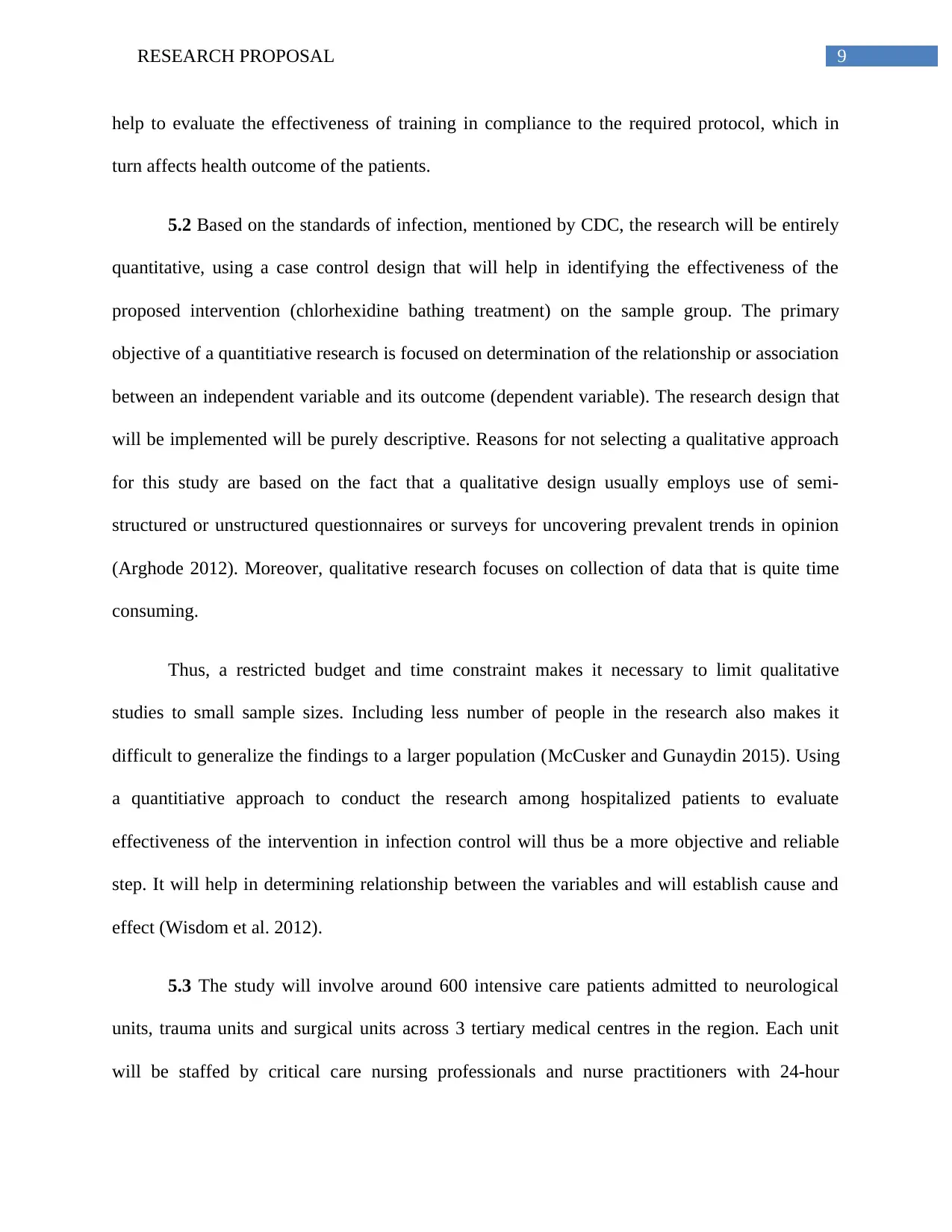
9RESEARCH PROPOSAL
help to evaluate the effectiveness of training in compliance to the required protocol, which in
turn affects health outcome of the patients.
5.2 Based on the standards of infection, mentioned by CDC, the research will be entirely
quantitative, using a case control design that will help in identifying the effectiveness of the
proposed intervention (chlorhexidine bathing treatment) on the sample group. The primary
objective of a quantitiative research is focused on determination of the relationship or association
between an independent variable and its outcome (dependent variable). The research design that
will be implemented will be purely descriptive. Reasons for not selecting a qualitative approach
for this study are based on the fact that a qualitative design usually employs use of semi-
structured or unstructured questionnaires or surveys for uncovering prevalent trends in opinion
(Arghode 2012). Moreover, qualitative research focuses on collection of data that is quite time
consuming.
Thus, a restricted budget and time constraint makes it necessary to limit qualitative
studies to small sample sizes. Including less number of people in the research also makes it
difficult to generalize the findings to a larger population (McCusker and Gunaydin 2015). Using
a quantitiative approach to conduct the research among hospitalized patients to evaluate
effectiveness of the intervention in infection control will thus be a more objective and reliable
step. It will help in determining relationship between the variables and will establish cause and
effect (Wisdom et al. 2012).
5.3 The study will involve around 600 intensive care patients admitted to neurological
units, trauma units and surgical units across 3 tertiary medical centres in the region. Each unit
will be staffed by critical care nursing professionals and nurse practitioners with 24-hour
help to evaluate the effectiveness of training in compliance to the required protocol, which in
turn affects health outcome of the patients.
5.2 Based on the standards of infection, mentioned by CDC, the research will be entirely
quantitative, using a case control design that will help in identifying the effectiveness of the
proposed intervention (chlorhexidine bathing treatment) on the sample group. The primary
objective of a quantitiative research is focused on determination of the relationship or association
between an independent variable and its outcome (dependent variable). The research design that
will be implemented will be purely descriptive. Reasons for not selecting a qualitative approach
for this study are based on the fact that a qualitative design usually employs use of semi-
structured or unstructured questionnaires or surveys for uncovering prevalent trends in opinion
(Arghode 2012). Moreover, qualitative research focuses on collection of data that is quite time
consuming.
Thus, a restricted budget and time constraint makes it necessary to limit qualitative
studies to small sample sizes. Including less number of people in the research also makes it
difficult to generalize the findings to a larger population (McCusker and Gunaydin 2015). Using
a quantitiative approach to conduct the research among hospitalized patients to evaluate
effectiveness of the intervention in infection control will thus be a more objective and reliable
step. It will help in determining relationship between the variables and will establish cause and
effect (Wisdom et al. 2012).
5.3 The study will involve around 600 intensive care patients admitted to neurological
units, trauma units and surgical units across 3 tertiary medical centres in the region. Each unit
will be staffed by critical care nursing professionals and nurse practitioners with 24-hour
Paraphrase This Document
Need a fresh take? Get an instant paraphrase of this document with our AI Paraphraser
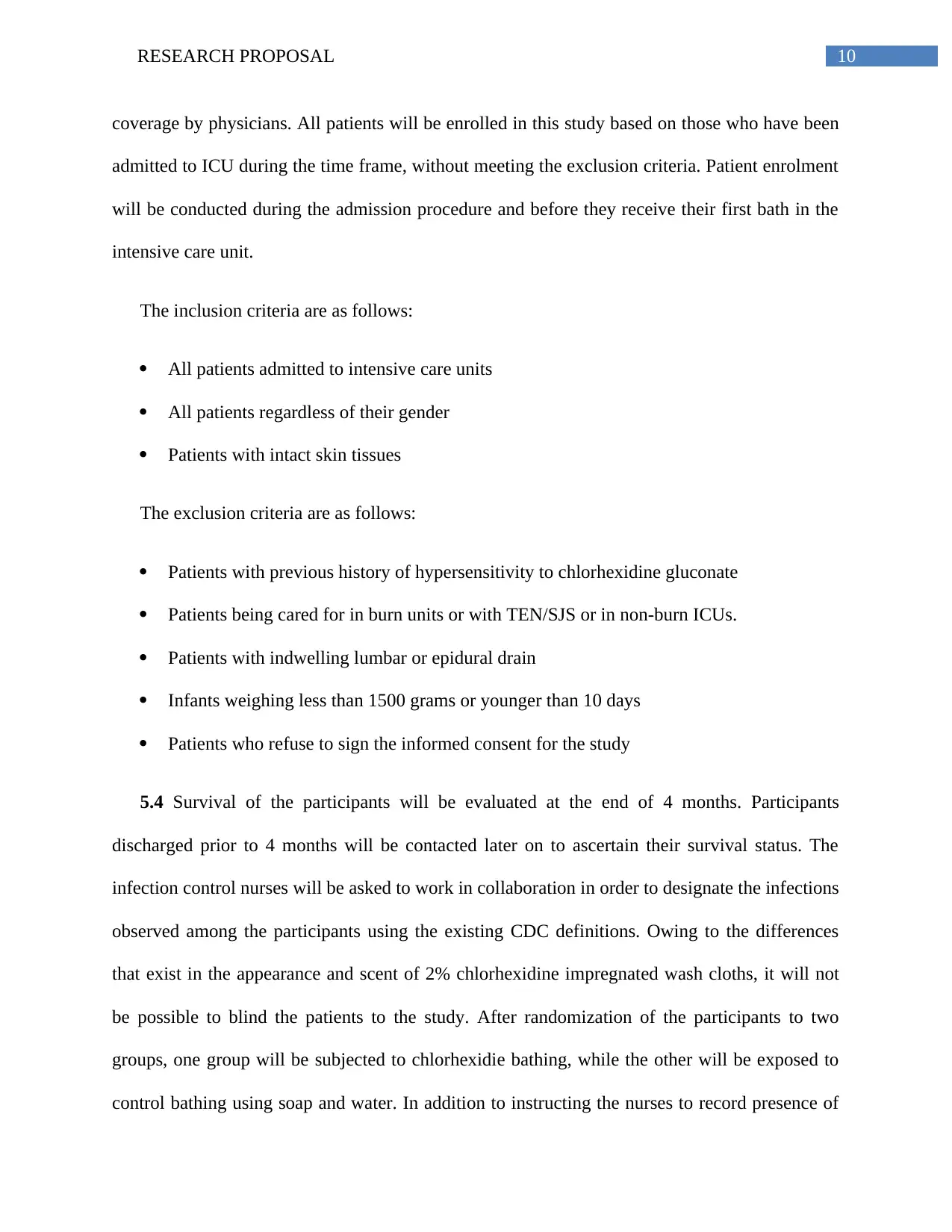
10RESEARCH PROPOSAL
coverage by physicians. All patients will be enrolled in this study based on those who have been
admitted to ICU during the time frame, without meeting the exclusion criteria. Patient enrolment
will be conducted during the admission procedure and before they receive their first bath in the
intensive care unit.
The inclusion criteria are as follows:
All patients admitted to intensive care units
All patients regardless of their gender
Patients with intact skin tissues
The exclusion criteria are as follows:
Patients with previous history of hypersensitivity to chlorhexidine gluconate
Patients being cared for in burn units or with TEN/SJS or in non-burn ICUs.
Patients with indwelling lumbar or epidural drain
Infants weighing less than 1500 grams or younger than 10 days
Patients who refuse to sign the informed consent for the study
5.4 Survival of the participants will be evaluated at the end of 4 months. Participants
discharged prior to 4 months will be contacted later on to ascertain their survival status. The
infection control nurses will be asked to work in collaboration in order to designate the infections
observed among the participants using the existing CDC definitions. Owing to the differences
that exist in the appearance and scent of 2% chlorhexidine impregnated wash cloths, it will not
be possible to blind the patients to the study. After randomization of the participants to two
groups, one group will be subjected to chlorhexidie bathing, while the other will be exposed to
control bathing using soap and water. In addition to instructing the nurses to record presence of
coverage by physicians. All patients will be enrolled in this study based on those who have been
admitted to ICU during the time frame, without meeting the exclusion criteria. Patient enrolment
will be conducted during the admission procedure and before they receive their first bath in the
intensive care unit.
The inclusion criteria are as follows:
All patients admitted to intensive care units
All patients regardless of their gender
Patients with intact skin tissues
The exclusion criteria are as follows:
Patients with previous history of hypersensitivity to chlorhexidine gluconate
Patients being cared for in burn units or with TEN/SJS or in non-burn ICUs.
Patients with indwelling lumbar or epidural drain
Infants weighing less than 1500 grams or younger than 10 days
Patients who refuse to sign the informed consent for the study
5.4 Survival of the participants will be evaluated at the end of 4 months. Participants
discharged prior to 4 months will be contacted later on to ascertain their survival status. The
infection control nurses will be asked to work in collaboration in order to designate the infections
observed among the participants using the existing CDC definitions. Owing to the differences
that exist in the appearance and scent of 2% chlorhexidine impregnated wash cloths, it will not
be possible to blind the patients to the study. After randomization of the participants to two
groups, one group will be subjected to chlorhexidie bathing, while the other will be exposed to
control bathing using soap and water. In addition to instructing the nurses to record presence of
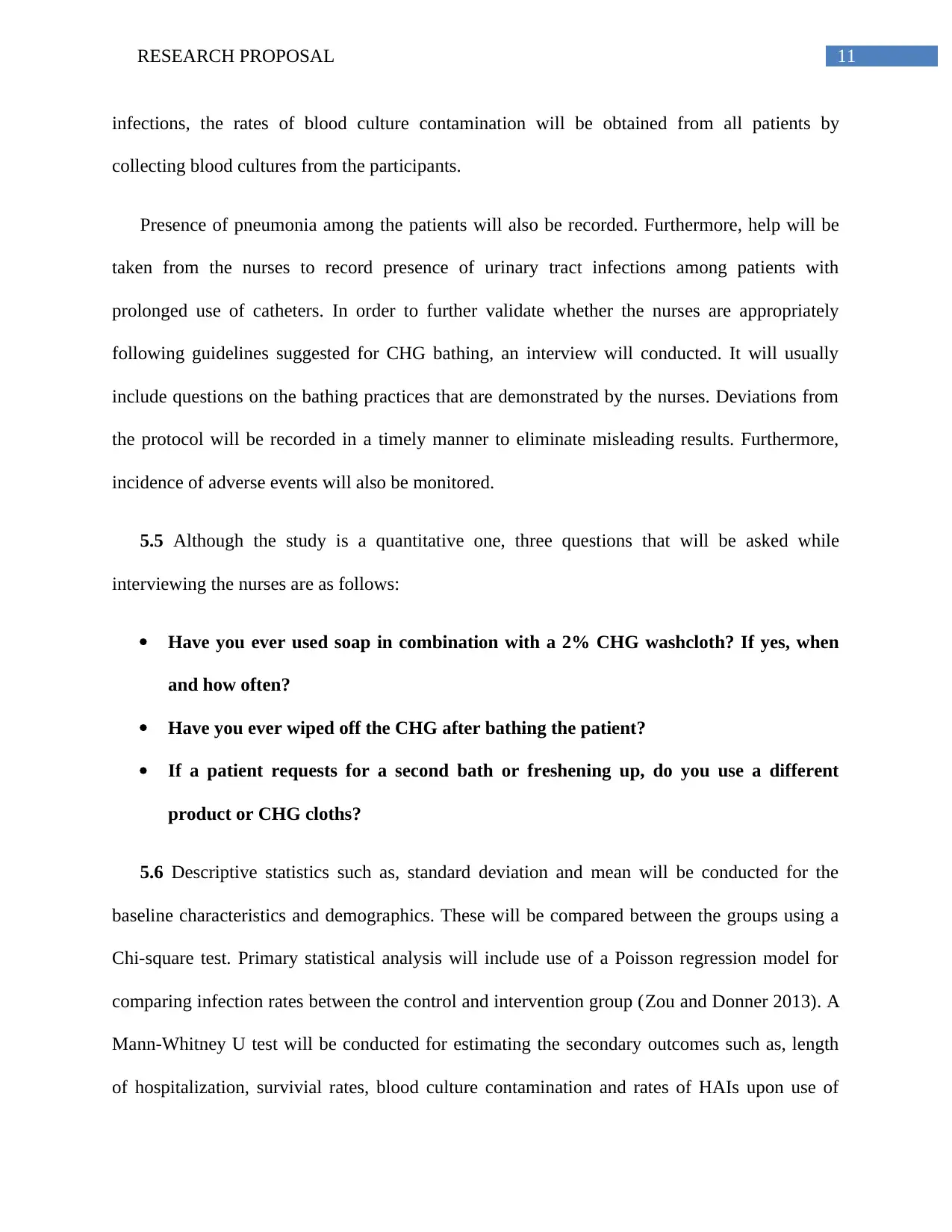
11RESEARCH PROPOSAL
infections, the rates of blood culture contamination will be obtained from all patients by
collecting blood cultures from the participants.
Presence of pneumonia among the patients will also be recorded. Furthermore, help will be
taken from the nurses to record presence of urinary tract infections among patients with
prolonged use of catheters. In order to further validate whether the nurses are appropriately
following guidelines suggested for CHG bathing, an interview will conducted. It will usually
include questions on the bathing practices that are demonstrated by the nurses. Deviations from
the protocol will be recorded in a timely manner to eliminate misleading results. Furthermore,
incidence of adverse events will also be monitored.
5.5 Although the study is a quantitative one, three questions that will be asked while
interviewing the nurses are as follows:
Have you ever used soap in combination with a 2% CHG washcloth? If yes, when
and how often?
Have you ever wiped off the CHG after bathing the patient?
If a patient requests for a second bath or freshening up, do you use a different
product or CHG cloths?
5.6 Descriptive statistics such as, standard deviation and mean will be conducted for the
baseline characteristics and demographics. These will be compared between the groups using a
Chi-square test. Primary statistical analysis will include use of a Poisson regression model for
comparing infection rates between the control and intervention group (Zou and Donner 2013). A
Mann-Whitney U test will be conducted for estimating the secondary outcomes such as, length
of hospitalization, survivial rates, blood culture contamination and rates of HAIs upon use of
infections, the rates of blood culture contamination will be obtained from all patients by
collecting blood cultures from the participants.
Presence of pneumonia among the patients will also be recorded. Furthermore, help will be
taken from the nurses to record presence of urinary tract infections among patients with
prolonged use of catheters. In order to further validate whether the nurses are appropriately
following guidelines suggested for CHG bathing, an interview will conducted. It will usually
include questions on the bathing practices that are demonstrated by the nurses. Deviations from
the protocol will be recorded in a timely manner to eliminate misleading results. Furthermore,
incidence of adverse events will also be monitored.
5.5 Although the study is a quantitative one, three questions that will be asked while
interviewing the nurses are as follows:
Have you ever used soap in combination with a 2% CHG washcloth? If yes, when
and how often?
Have you ever wiped off the CHG after bathing the patient?
If a patient requests for a second bath or freshening up, do you use a different
product or CHG cloths?
5.6 Descriptive statistics such as, standard deviation and mean will be conducted for the
baseline characteristics and demographics. These will be compared between the groups using a
Chi-square test. Primary statistical analysis will include use of a Poisson regression model for
comparing infection rates between the control and intervention group (Zou and Donner 2013). A
Mann-Whitney U test will be conducted for estimating the secondary outcomes such as, length
of hospitalization, survivial rates, blood culture contamination and rates of HAIs upon use of
⊘ This is a preview!⊘
Do you want full access?
Subscribe today to unlock all pages.

Trusted by 1+ million students worldwide
1 out of 21
Related Documents
Your All-in-One AI-Powered Toolkit for Academic Success.
+13062052269
info@desklib.com
Available 24*7 on WhatsApp / Email
![[object Object]](/_next/static/media/star-bottom.7253800d.svg)
Unlock your academic potential
Copyright © 2020–2025 A2Z Services. All Rights Reserved. Developed and managed by ZUCOL.





